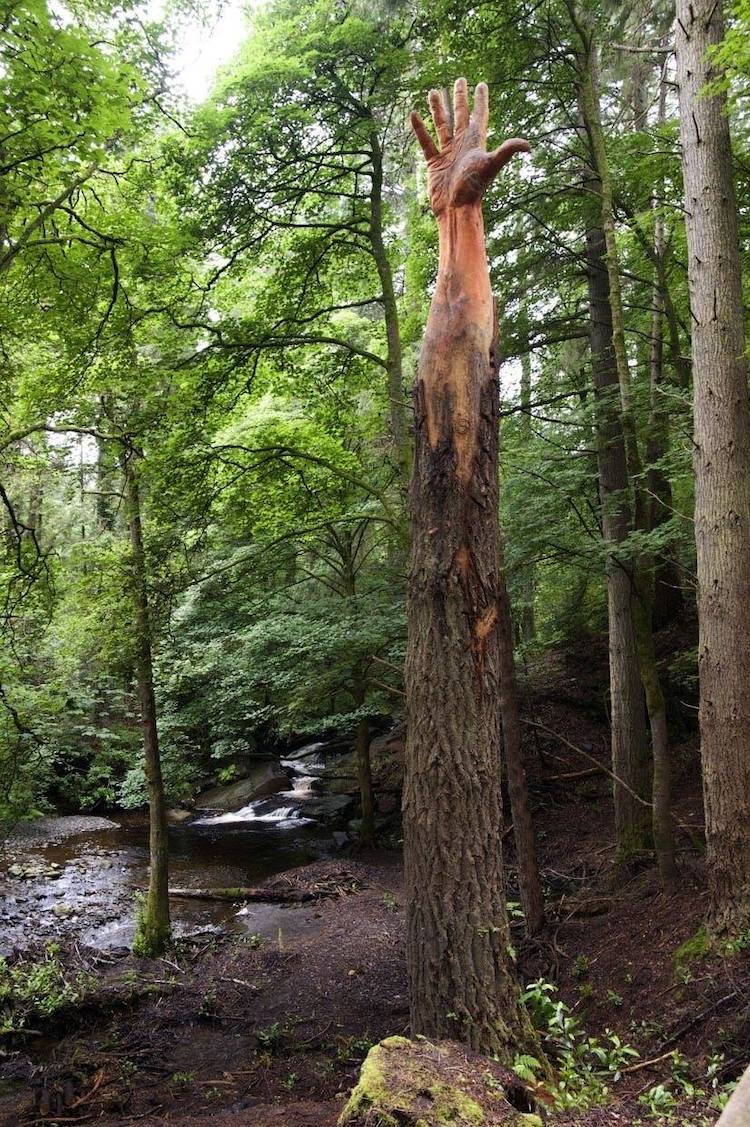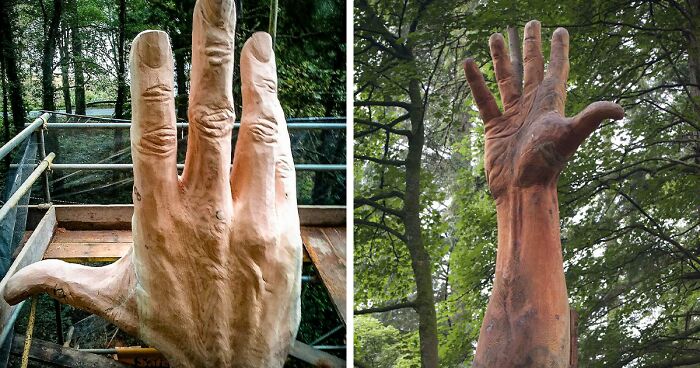In the lush Welsh countryside near Pontarfynach, a magnificent giant once stood proudly against the horizon. For generations, the Douglas fir known as “the Giant Redwood” reigned as Wales’ tallest tree, stretching an impressive 124 feet toward the sky. Nature enthusiasts, hikers, and locals cherished this majestic sentinel that had watched over the landscape for over 150 years. Then came the storm that would forever alter its destiny—but not in the way anyone expected.
In 2018, severe storms battered the Welsh countryside. Wind gusts exceeding 90 mph tore through forests, and the mighty Giant Redwood could withstand no more. The damage was catastrophic; the once-proud titan was left broken and posed a significant safety hazard. Local authorities made what seemed the only logical decision: the remainder would need to be cut down entirely, removing the last traces of this natural landmark.
For many locals, this news was heartbreaking. The tree had been more than just vegetation; it was a landmark, a meeting point, a subject of countless photographs, and a symbol of endurance. Its planned removal felt like losing a piece of cultural heritage. But fate had a different plan when chainsaw artist Simon O’Rourke heard about the tree’s predicament.
Simon O’Rourke was already well-known in Wales for his remarkable chainsaw sculptures, transforming dead or damaged trees into works of art. When he learned about the Giant Redwood’s impending fate, he approached the landowners with an alternative solution: rather than removing the tree entirely, why not transform it into something that would honor its legacy?
O’Rourke’s proposal was striking in its symbolism and ambition. He envisioned transforming the broken trunk into a massive sculpture of a hand—a hand reaching toward the heavens, just as the tree had done throughout its long life. This “Giant Hand of Vyrnwy” would not only preserve the tree’s physical presence but would imbue it with new meaning, telling a story of resilience and transformation.
The landowners, captivated by O’Rourke’s vision, gave their approval. What followed was one of the most challenging projects of the artist’s career. Working with a damaged, 50-foot trunk of a mighty conifer presented unique difficulties. The wood was harder than many species O’Rourke typically sculpted, and the scale of the project was unprecedented.
Using chainsaws of various sizes, chisels, and other specialized tools, O’Rourke began the painstaking process of bringing the hand to life. The work took place over six intense days of carving, often in challenging weather conditions. O’Rourke worked from scaffolding, carefully shaping the massive fingers reaching skyward, detailing the knuckles, and defining the wrist where it emerged from the trunk.
The technical challenges were immense. Maintaining proportion at such a large scale required constant assessment from different angles and distances. The natural shape and grain of the wood dictated certain aspects of the design, requiring the artist to adapt his vision to work with nature rather than against it. This collaborative approach between artist and material resulted in a piece that feels both deliberate and organic.
When the scaffolding came down and the dust settled, what remained was nothing short of breathtaking. The “Giant Hand of Vyrnwy” stood as a 50-foot testament to artistic vision and natural wonder. From a distance, the sculpture creates the powerful illusion of a massive hand pushing up from the earth, fingers stretching toward the clouds in one final, eternal reach for the sky.
The symbolism resonated deeply with visitors. Here was the tree, no longer able to grow taller through its natural processes, yet still reaching upward through human creativity. The sculpture brilliantly captures both loss and continuity—acknowledging that while the living tree is gone, its story and presence continue in a new form.
Since its completion, the Giant Hand of Vyrnwy has become an unexpected cultural phenomenon. What might have been merely a sad footnote in local history—the day the tallest tree fell—has instead become a celebration of creative problem-solving and artistic vision. Tourists now visit specifically to see the sculpture, bringing new attention to the region and its natural beauty.
Photographers, artists, and poets have found inspiration in the massive wooden hand. It appears regularly in Welsh tourism materials and has been featured in international art publications. Social media has spread images of the sculpture worldwide, often accompanied by reflections on sustainability, the relationship between humans and nature, and the power of art to transform tragedy into beauty.
Local schools use the sculpture as a teaching tool about ecology, art, and community problem-solving. Children learn that when something precious is damaged, creative thinking can sometimes preserve its essence in new and meaningful ways.
Beyond its artistic merits, the Giant Hand of Vyrnwy carries an important environmental message. In an age of climate change and increasing extreme weather events, the sculpture stands as a reminder of nature’s vulnerability and the importance of preservation. It demonstrates a different approach to managing damaged natural landmarks—one that honors their history rather than erasing it.
The project has inspired similar initiatives elsewhere, with communities seeking creative alternatives when beloved trees reach the end of their natural lives. Rather than complete removal, more landowners are considering artistic transformations that maintain a connection to what once was.
In this way, Simon O’Rourke’s inspired intervention did more than save a single tree from disappearing entirely—it helped shift perspectives on how we might better honor the natural world even as we adapt to its changes. The Giant Hand of Vyrnwy reaches not just for the sky, but toward a future where art and nature intertwine in mutual respect and celebration.




